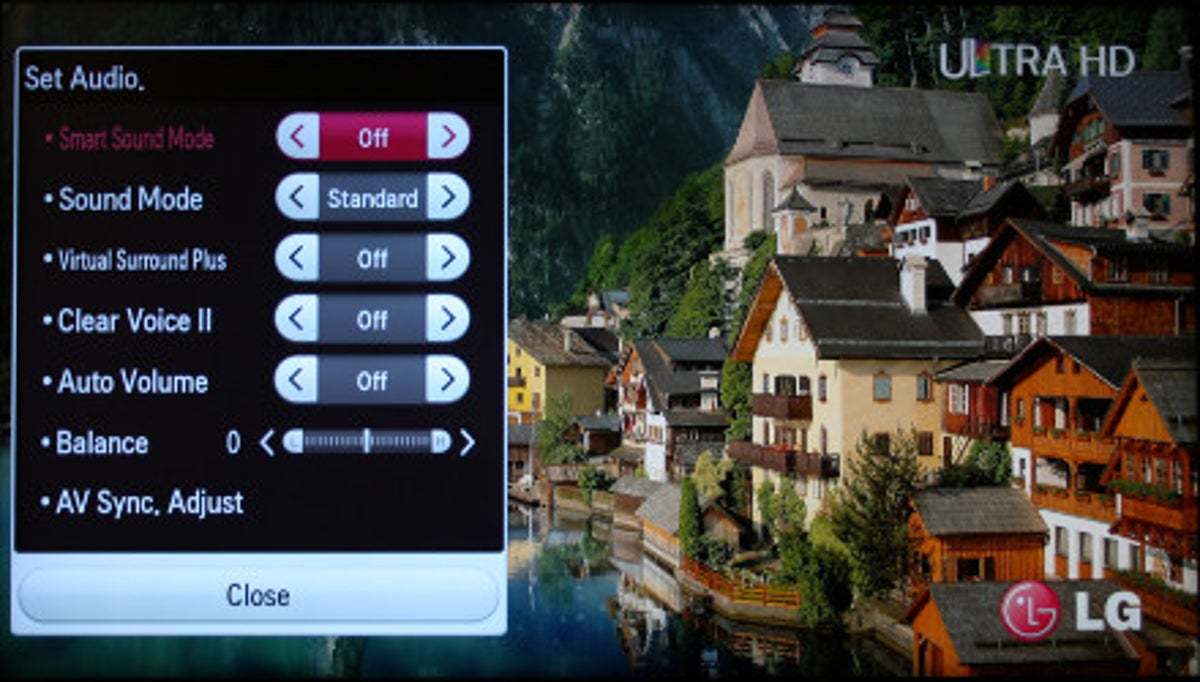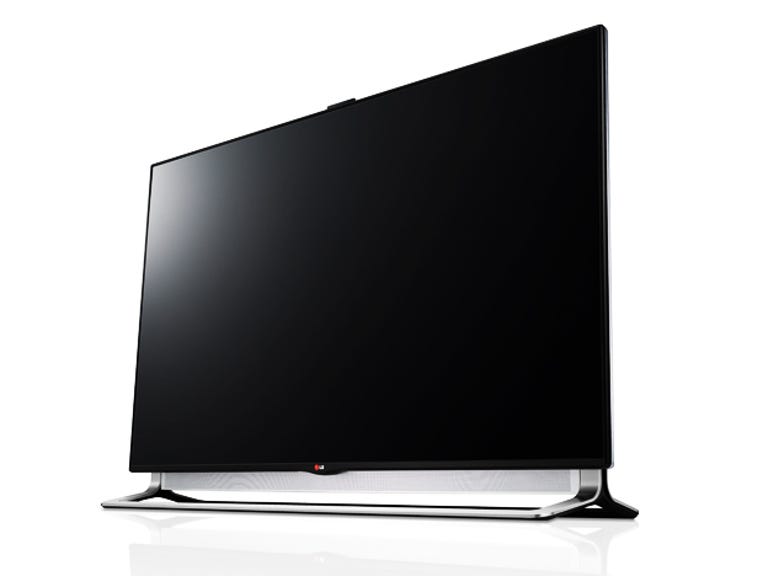 Why You Can Trust CNET
Why You Can Trust CNET LG 65LA970W review: LG 65LA970W
With its slim bezel and cool motorised soundbar, LG's 65LA970 is a really handsome TV. It produces great pictures too, but Ultra HD is hardly worth it on a screen this size.
LG was pretty quick out of the blocks when it came to 4K, putting out its 84-inch model ahead of most of its rivals. The 65LA970W is essentially a smaller version of that TV. It still sports an Ultra HD panel, but its smaller 65-inch screen size means that it's probably a more palatable option for most homes.
The Good
The Bad
The Bottom Line
Currently John Lewis is selling it for £4,499. Support for Ultra HD doesn't come cheap, but this set is £500 cheaper than Sony's KD-65X9005. The LG does have a much slimmer bezel though and it supports local dimming of its LED backlighting. It has some weaknesses, however, so you may not want to drain your bank balance of four and a half grand just yet.
TV guide
Although this is a 4K TV, its menu system has the same look and feel as LG's Full HD tellies -- but when it ain't broke, why fix it? LG's system hasn't changed a huge amount over the last couple of years, but it's still attractive, logically laid out and speedy to navigate.
The picture menu, for example, offers all the basic contrasts, sharpness and colour controls, while in the expert and advance menus you'll find extras such as settings for the motion processing and a full colour-management system.

LG's Freeview programming guide has been lagging behind the competition for a while now and the one on this TV is no different. It could definitely do with an update as it looks quite basic and lacks some of the more advanced features now found on other brand's TVs, such as the TiVo-like suggestions included on Samsung's sets.
Smart TV
LG's smart TV isn't quite on a par with Samsung's system either, but it's still pretty good. It's presented as a homescreen with a series of panels across the top, divided into categories such as premium apps, 3D online content, Smartworld apps (all the non-premium stuff) and media that you've shared to the TV from your computer. LG's motion controller, which is like a mouse you wave around in the air, makes it quick to move through the menus and launch apps.
The line-up of apps is on the whole pretty good. Along with BBC iPlayer, it also has Lovefilm and Netflix onboard and there are also apps for Facebook and Twitter, as well as premium movie rental services, such as KnowHow. LG is also the only manufacturer to currently support Sky's Now TV service. It still lacks support for ITV Player, Demand 5 and 4oD however, which are all available on Samsung's platform.
As with all of LG's smart TVs, this one has a good integrated media player so you can either play files locally from its three USB ports or alternatively stream them across a network from a PC or networked hard drive. And unlike Sony's 4K TVs, this model supports HEVC, so it can play compressed HEVC 4K files via its media player.
Editor's note: LG has promised that its smart TVs will receive an update to stop them transmitting data on viewing habits and streaming media, following widespread concerns over user privacy. Read more here.
Design and connections
With its 65-inch screen, the LA970W is, of course, a humungous TV, but its design makes far less domineering in a room than Sony's slab-like KD-65X9005. In part, this is due to the slimmed-down bezel, which is just 1cm wide. This combined with the elegant stand gives the TV a much lighter feel than Sony's model. So, despite its large size, it's a very stylish telly that looks every inch the high-end set that it is.
The ports are fairly evenly distributed between a panel on the left-hand side of the set and a corresponding row that runs along the rear. Here you'll find three HDMI ports as well as a pair of USB 2.0 sockets and a single USB 3.0 socket. There's a coax input for Freeview HD and an HD satellite port.
As the satellite tuner supports the HEVC codec it should be able to receive Eutelsat's experimental 4K channel. To pick up this channel however, you need a dish pointed at a different satellite to the one Sky uses so I couldn't test this out unfortunately. Naturally there's Ethernet onboard and Wi-Fi built-in, and you get breakout cables for legacy connections such as Scart and component.
There are two issues with the HDMI ports, though. Firstly there are only three of them, when most other high-end TVs have four, and secondly the ports only support HDMI V1.4. This means that they're currently limited to supporting 4K video signals at up to 30fps, whereas Panasonics' latest Ultra HD model supports 4K video at up to 60fps, which is what the new HDMI 2.0 standard demands.
Support for faster frame rates is important because broadcasters may use them for future sports channels. Unfortunately, LG hasn't provided any information on whether it's planning to upgrade this set's ports or not, so it's definitely something we'd think carefully about before shelling out on this TV.
4K picture quality
There's an increasing number of 4K TVs hitting the market, but there's still pretty much a total dearth of 4K content. One benefit this model has over Sony's KD-65X9005 is that it supports HEVC, so you can at least play back clips in Ultra HD via drives plugged into its USB ports. LG supplied a number of clips in 4K to view on the TV, but I was also able to play back 4K test files in MKV and MP4 format that I had downloaded from the Web.
Up-close the 4K footage looks stunning. Even with your nose pressed up against the screen the detail on offer is astounding. Think of the iPad with a retina display versus the original iPad to get an idea of the increase in clarity.
As you move away from the screen to a more normal viewing distance though, the increase in resolution is much less apparent and at around eight foot it's difficult to tell the difference between Ultra HD and Full HD footage in terms of crispness and clarity. Even back to back with a 60-inch Full HD Samsung plasma the difference was very, very small at around 2m. So unless you want to sit very close to your TV, we think you're going to need a bigger screen than 65 inches to make the jump to 4K really worthwhile.
General picture quality
The LA970W, on the whole, puts in a pretty good picture performance. Its colours are bold and strong and its support for local dimming allows it not just to produce startlingly bright whites, but also very deep black levels.
It also does a good job of upscaling both standard definition and HD content to fill all those extra Ultra HD pixels. Standard definition broadcasts look marginally better on this model than the Sony KD-65X9005. The Sony produced better results when upscaling HD video to 4K though as its algorithms seemed to finesse the picture more to add sharpness without increasing picture noise.
The LA970W's motion processing is fairly good too, especially if you tweak the default settings to bring the aggressiveness of the processing down a good few steps. That way you can achieve less blur and judder, without pictures suffering from unnatural smoothness and flicker on the edges of moving objects in the frame.
Unfortunately it's not all plain sailing, as this TV has a fairly irritating picture flaw that quickly becomes apparent when watching sports broadcasts such as F1 and footy. Basically, when it's dealing with camera pans you can see banding -- vertical strips of brighter and darker areas -- in the picture as the camera sweeps to the left or right. These disappear once motion stops. I presume this is due to the direct LED backlighting, but I can't be 100 per cent sure of this.
It is something that has cropped up on smaller LED screens, but it's much more noticeable and distracting on this one, presumably because it's such as large screen. Also, unlike most screens that use IPS panels, the viewing angle on this set isn't very wide. When you move out of the central viewing point by around 25 degrees you start to see more haloing from the direct LEDs behind the screen.
It's a shame, as when viewed head-on, LG's direct backlighting actually works really well, providing very even looking lighting across the display with only quite minimal haloing of bright objects against dark backgrounds.
3D picture quality
The success of Gravity at the cinema may spark more interest in 3D in the home, and the LA970W is ready to show just what a good experience that can be.
It uses LG's passive technology, so the glasses are light and comfortable to wear and don't exhibit the flickering that you get with active 3D glasses. Passive Full HD 3D screens suffered because they halve the horizontal resolution leading to a drop in apparent sharpness. This set has a much higher resolution than 1080p, however, so it's able to deliver Full HD 3D images to each eye.
The results are astoundingly good. Its images are much brighter than the vast majority of active 3D sets and the lack of flicker and crosstalk means they also have a much more solid and realistic feel than most other TVs. It really does show just how good 3D in the home can be.
Audio quality
One of the coolest elements of the design of this TV is its integrated soundbar. When the TV is off, this is tucked up into the underside of the chassis, but when you turn the TV on, a motorised mechanism lowers it down so it sits just above the telly's stand.
This bar contains four angled speaker drivers and works in conjunction with a mini-subwoofer that's mounted on the rear of the TV's chassis. All five of these speakers firing in unison gives it pretty meaty audio quality. It sounds much more open and crisp than the vast majority of today's slim flatscreen sets and the sub on the rear also helps it add some low-end rumble into the mix. It's not on a par with the sound system built in to Sony's KD-65X9005, but then that model's huge speakers do look quite ugly.
Conclusion
There are plenty of things to like about this 4K 65 incher from LG. Its slim bezel, clean lines and classy motorised soundbar means it looks the business, the local dimming helps it produce very deep black levels and its passive 3D performance is excellent.
LG hasn't announced whether it'll receive any kind of upgrade to its HDMI ports, and the picture banding caused by its direct LED backlighting is noticeable enough to be annoying, especially when you're watching sports broadcasts. Also, like all Ultra HD screens at this 'smaller' size, the benefits of 4K aren't hugely apparent at a normal viewing distance of 2m or so. Sadly for LG, then, this model's positives just don't outweigh its negatives.


